‘Sitting under the mistletoe
(Pale-green, fairy mistletoe),
One last candle burning low,
All the sleepy dancers gone,
Just one candle burning on,
Shadows lurking everywhere:
Some one came, and kissed me there.’
‘Mistletoe’ by Walter De La Mare
You should be careful about letting the past into your life. What starts as a trickle soon becomes a rich stream and like all rivers- it will occasionally flood. This time last year, I received a Christmas postcard from New York. The postage stamp shows it was sent in 1910 by ‘Charlie and Emily’ and addressed to a ‘Mr and Mrs J. Miller’. The card arrived at our house in Addington Street, Ramsgate on the 23rd December 2016, bringing with it the final flurry of Christmas post… As well as the first of several ghosts.
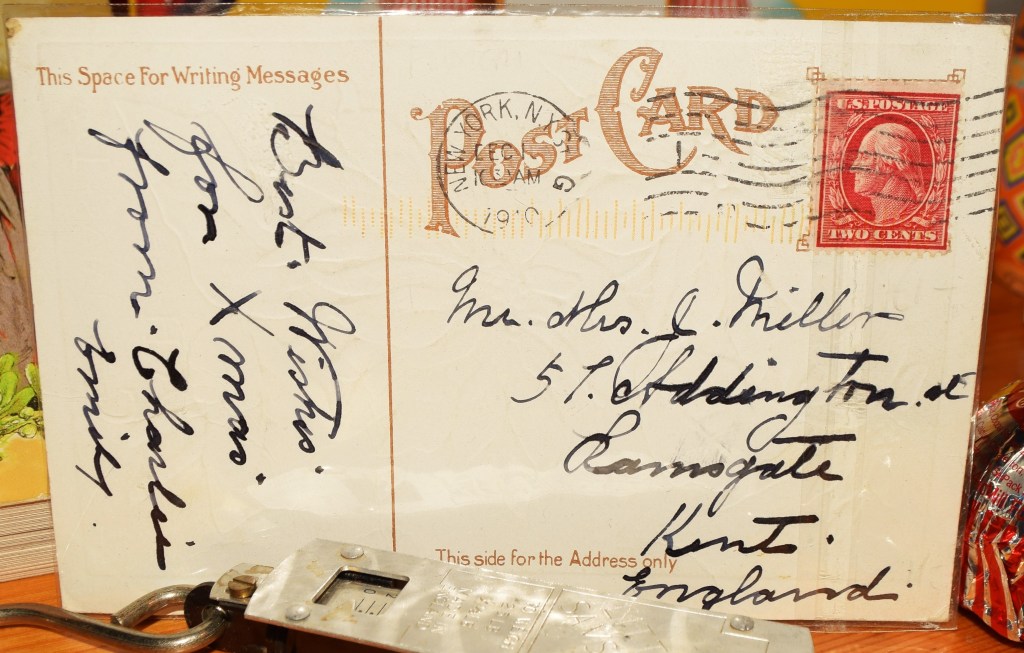

It didn’t take long to establish that the Millers did not live at my address. But given the subsequent thrall in which the postcard was to hold me, this now seems irrelevant.
The ‘1’ on the card’s house number is either wrong, or a hastily scribbled ‘7’. The 1911 census confirms that Mr John Miller was a resident of Addington Street, but that he lived three houses away in number ’57’; the ‘Queen Charlotte’ pub- one of my favourite locals. It turns out that he was the tavern’s landlord (or ‘licensed victualler’ according to the census).

The bar’s current manager is a friend of mine- also called John; this neat piece of symmetry should have been my lifebuoy back to modern times, but by this point I’d been carried too far downstream into the past. It didn’t help that when the card arrived, I already had my toes in the water, so to speak.
At the time I’d been struggling with the loss of my grandmother, who had only recently passed away. The festive period can bring back so many memories. The core of my problem lay in the fact that I watched her die. Or at least I thought I did. I know for certain I saw her stop breathing. She’d been unconscious for a week and the rhythm of her breath was all we had left. Inhale. Exhale. Up, down. Pause… Up, down. Pause… Up. Down some more… Days passed and the pauses became longer. Then longer again… Until, as I watched, one of the pauses became infinite.
No more breathing. You leave the hospital, you attend the funeral and you talk about old times.
But that pause still exists. In your quieter moments, you can still feel it- and listen for it just like you did the final breaths of the departed.
The strange thing is that afterwards I kept on breathing- and living. To me, the only thing my nan had stopped doing was the former. In my mind, she was still very much alive. My grandmother had been the head of the family; a grand figure and the last remaining ‘elder’. Born in 1925, she anchored us to another era- and I wasn’t ready to be cut adrift. I heard the term ‘closure’ being bandied around- but I don’t think this word helps or is all that relevant. In England, our chief problem with grief is not so much how we deal with death- but how we perceive times gone by. To most British, the past really is a foreign land- and I don’t think it should be. In fact, I’ve come to appreciate that it can’t be.
In the months after my nan departed, I was told by relatives that she’d actually worked in my road- Addington Street- over forty years ago; she was the book-keeper for the butcher’s just a few yards down from my house. I’d either forgotten or not known this. My uncle worked there too as the bicycle delivery boy; at this time of the year, he used to take their turkeys all over Ramsgate. It’s all gone now- but many traces of the old road have been left behind, including the butcher’s original shop front and several end of terrace advertisement prints, or ‘ghost signs’ as they’ve now become known. There are two just over the road from my front door.
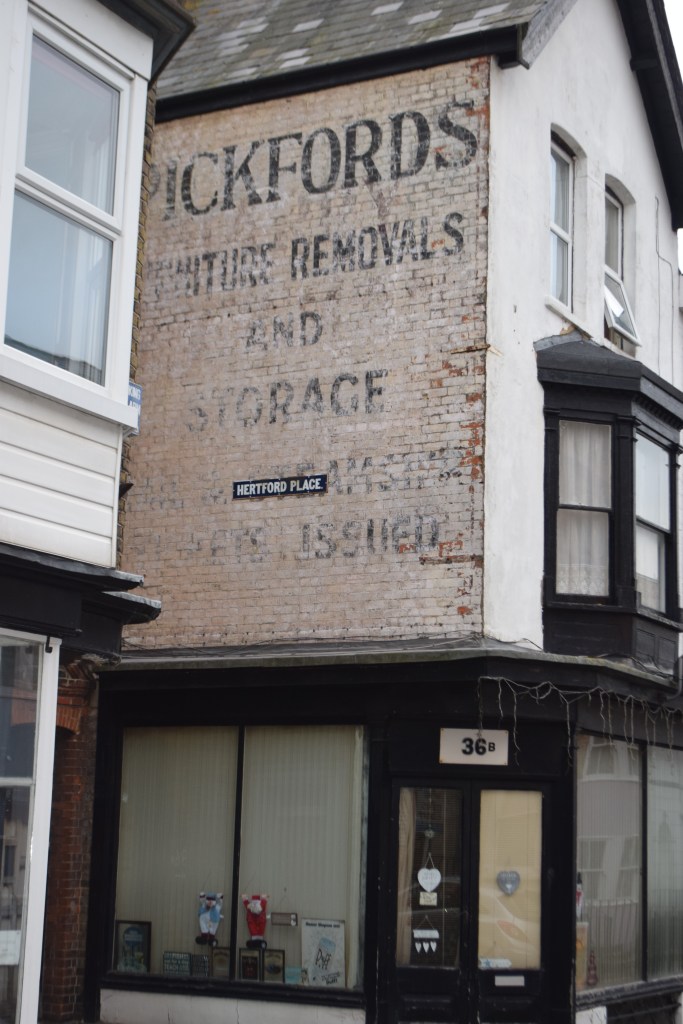
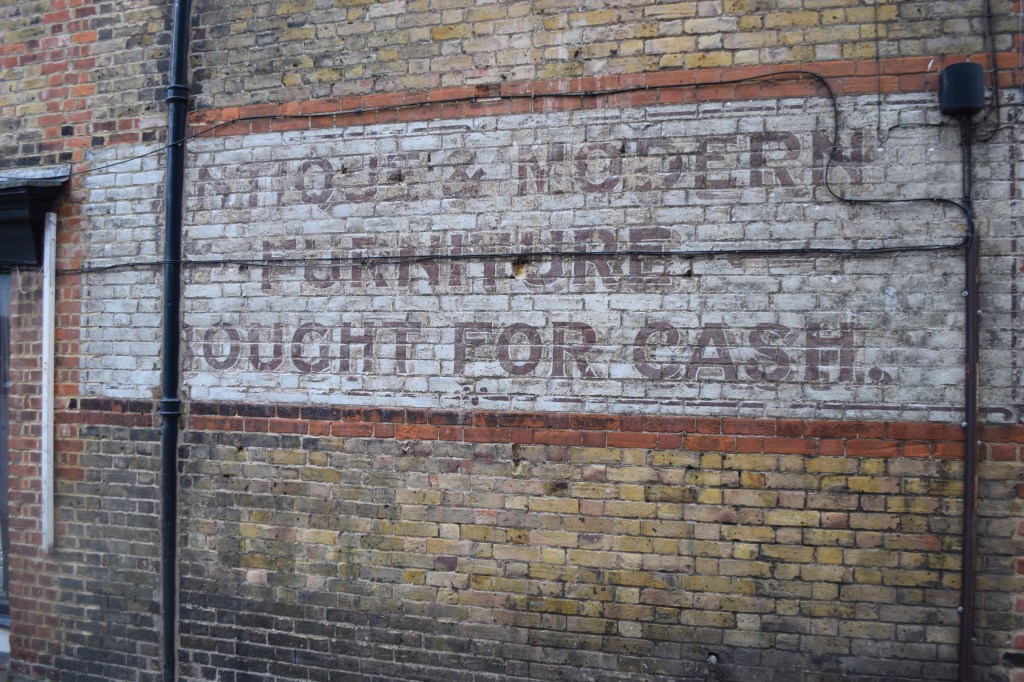
The arrival of the postcard, especially at Christmas time, intensified my curiosity about the past. The records show that Mr J Miller survived the first world war; but whilst looking for him I found lots of other Millers in Ramsgate- many of whom did not share his fortune. Moreover, I came to be reminded that a huge number of Ramsgate’s men never came back from France. If you are looking for information on anybody living in the town during the first part of the twentieth century, then you simply won’t escape the spectre of the wars- they infiltrate every part of its culture.
Addington Street is no different. In the first world war, the road lost many young boys. Then in the second world war, both men and women died here when the street was bombed by the Luftwaffe; they were keen to lose any remaining poundage before departing for the nearby English Channel, whose shoreline is just a few yards from the bottom of the road. I also discovered that Ramsgate as a whole was bombed far more intensively than I’d thought- so much so that it featured more than once on Winston Churchill’s itinerary of flying ‘morale visits’ up and down the country.

It happens less and less, but people often lay memoriam wreathes nearby- in honour of the war dead; this Christmas, somebody attached one to the clifftop railings just a few yards down from where Addington Street turns onto the esplanade. It reads: ‘To all those who left this harbour and gave their lives, So we might see this day’.
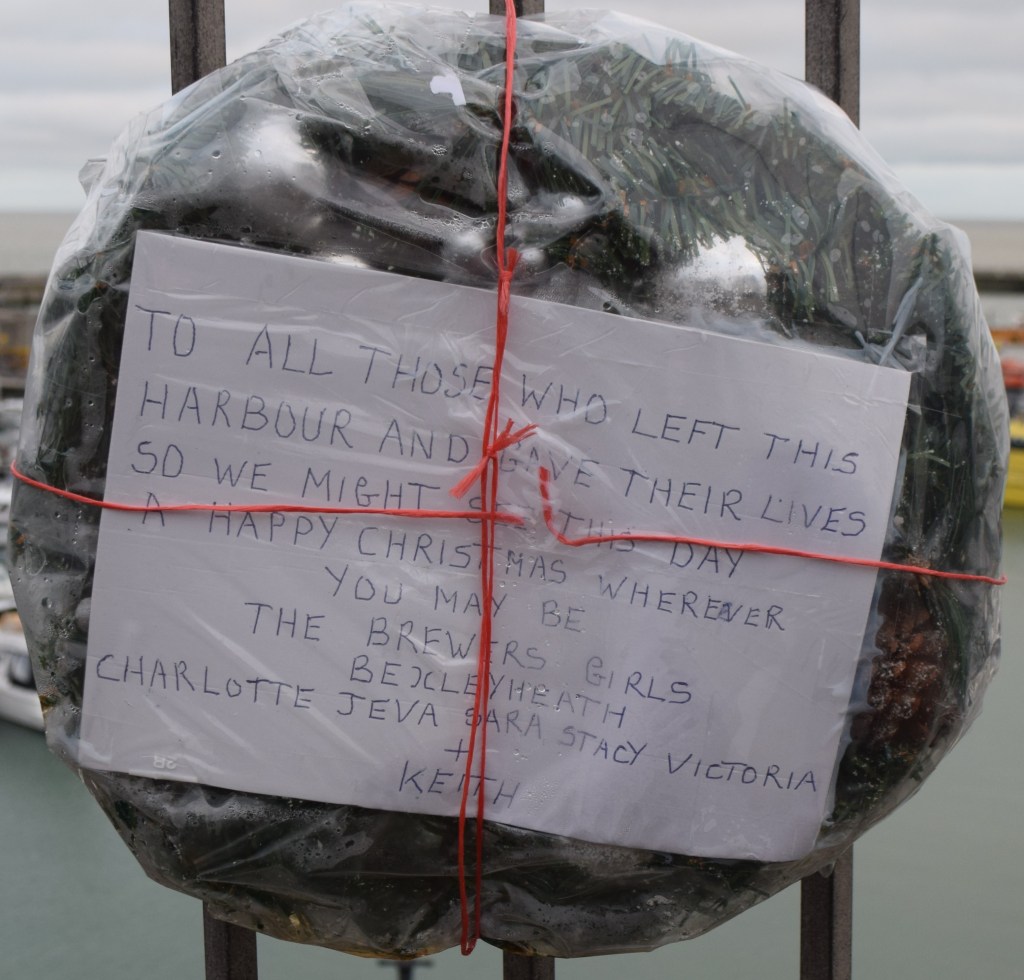
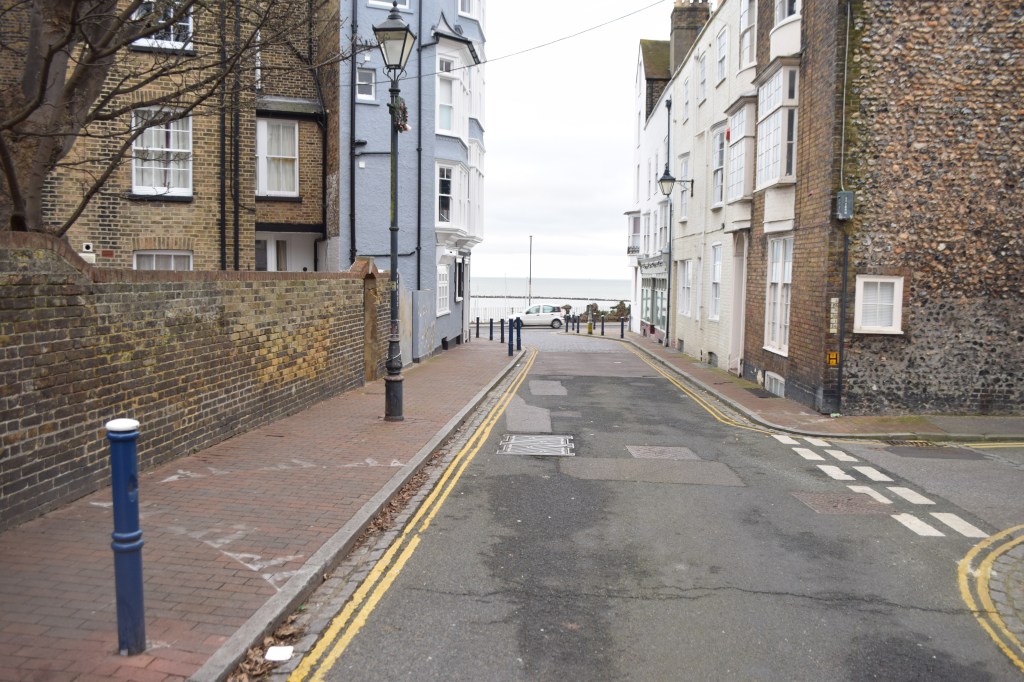
The more I dug, the more the postcard became a kind of totem for the past, broadening my view of death, time and loss. Gradually, it developed an aura of eeriness in the way some old objects do. I now view my town very differently- and my home, too. At first it was strange to think that other people, albeit not the Millers, lived in my house before I did. That they once sat where I sit, slept where I sleep and ate where I eat. After a while these observations developed from a childish curiosity into a mild burden upon my imagination; so I decided to find out more about them.
My hope was that by establishing some concrete facts, I could lend these figures a little flesh and perhaps exorcise their more nebulous forms from my mind… And in particular from my kitchen, where by now we’d stuck the postcard to the wall. I often sit there for a late supper and at times I’d begun to believe I wasn’t alone. Invariably these occasions were late at night and sometimes I’d visited the local tavern- the ‘Queen Charlotte’- just prior to experiencing these feelings, which may explain why the sensations were never unpleasant. Moreover, the kitchens in these local houses are situated in the basements and tend to have a warm, cave-like cosiness about them.
But not in all cases. I used to live around the corner in Spencer Square, which must hold the record for Ramsgate related hauntings. The basement area of that house felt anything but ‘cosy’. A friend, who stayed down there for a while on a camp bed, complained of strange nightmares and an unfriendly atmosphere in the night. More worryingly, my brother is adamant that an unseen ‘someone’ touched him when he was down there making a cup of tea. But my kitchen in Addington Street has an especially lovely feel to it; although you do often feel ‘accompanied’, for want of a better word.
Ultimately, the postcard (and my kitchen) got the better of me. I had to know something about the previous residents so I searched the archives of the local library, ransacked the town records section of ‘Michael’s book shop in Ramsgate and harassed some elderly neighbours. Eventually, I followed up on some recurring names and found the original 1911 census document for my address. It shows that a man named Alfred Charles O’Leary lived here with his wife Sarah Jane and their two daughters Prudence and Agnes.
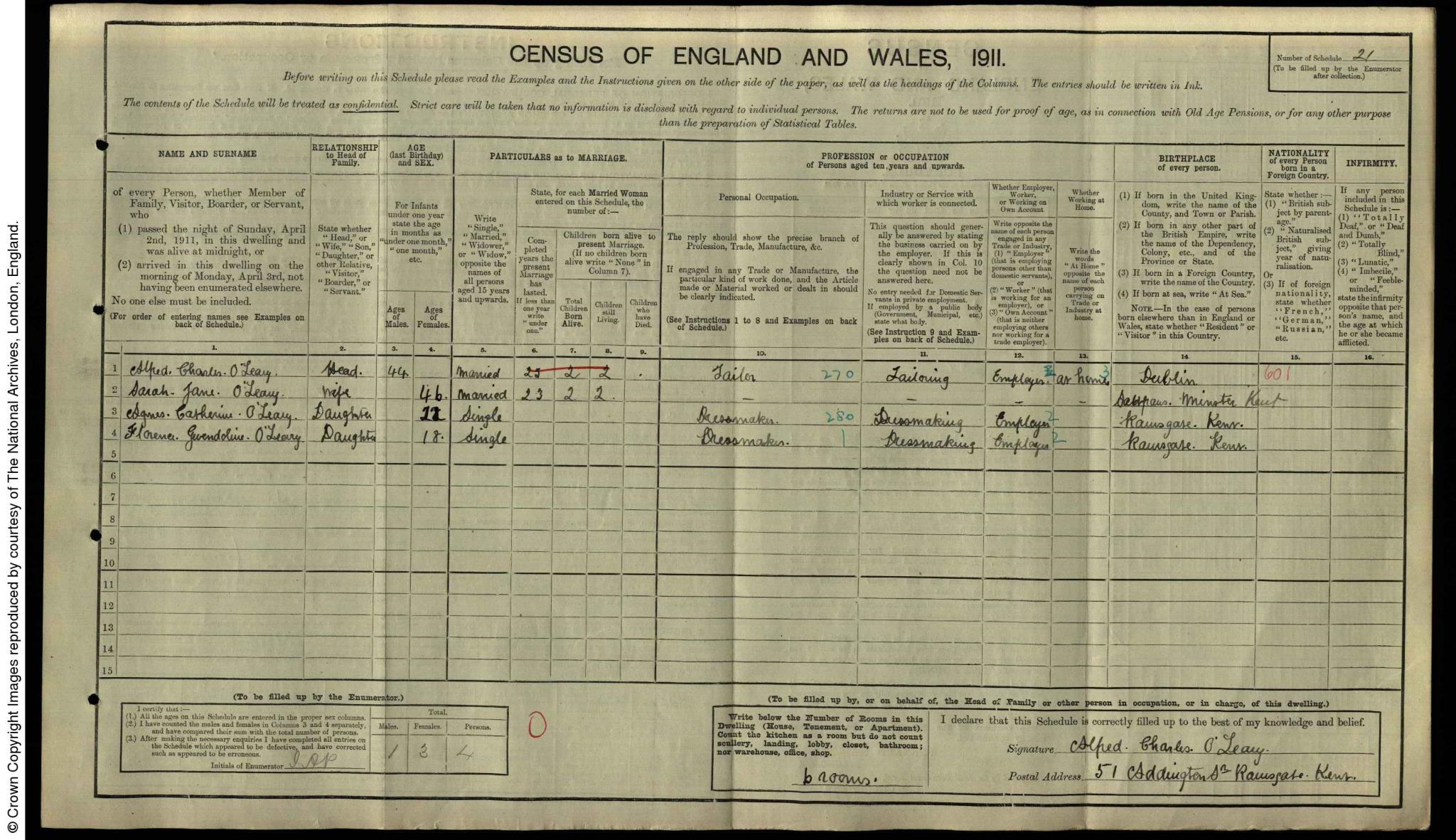
Alfred had emigrated from Dublin when he was 8 years old and met his wife locally. She was from Minster, but interestingly the village is preceded on the census form by the single word, ‘Saltpan’; I don’t know whether this was the name of an adjoining hamlet or a reference to some kind of salt-works. Today, there is no trace of it.
As for the family as a whole, they all lived long and (from what I’ve gathered) happy lives. The girls went on to marry local men with whom they grew old, both eventually passing on in the second part of the twentieth century. By this point, my nan was living in the town and happily married to my grandfather.
Like Alfred, she came from a large Irish family who’d emigrated to England to look for new opportunities. Like the girls who lived in my house, she raised a big family and lived a long, happy life.
I’ve come to realise that there is no panacea for grief. But in the end, these rough symmetries- and the world in which I found them- finally gave me the balance I needed to swim back to present shores.
… As well as the guts to sit in my kitchen late at night…
As for the postcard? Its pandoran task fulfilled, I placed it into an old tin box that I’ve owned since childhood. There are odd toys in there, old school prizes and other letters, too.
The tin is only ever opened when I put something in it.
And I may never do so again.
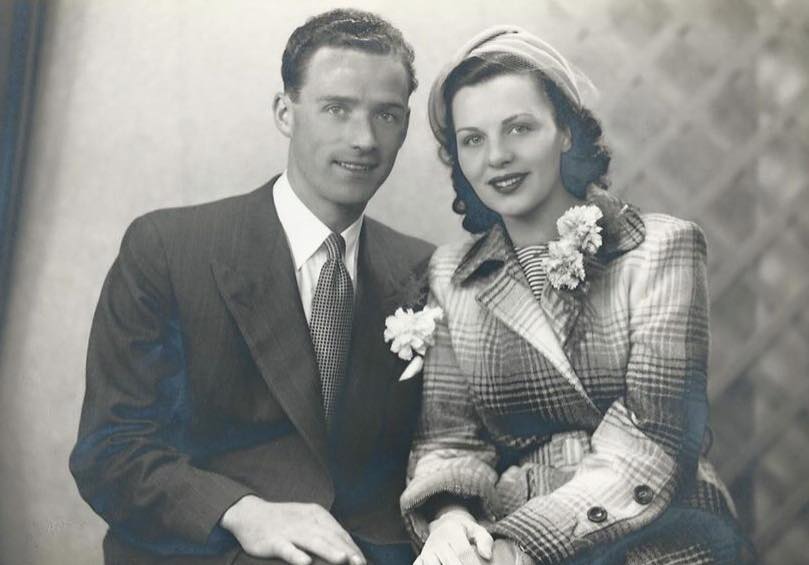
Fabulous pros Gareth. I wish you would help me with my book. Also my nan Flo (Rip) who was was born in West Ham in the late nineteenth century fell in love and had the guts to marry a black seaman from the West Indies named Charles Elvy. We are trying to trace him for our family tree but so far no luck. So in your wandering if you come across a Florence Humphreys and Charles Elvy (who used to come hop picking down here) please let me know 😍. By the way I have a few lively young male ‘spirits’ from the past who muck about in my basement kitchen in Spencer Square, but they are a part of my present family here now. 🔔
LikeLiked by 1 person
Hello Linda! Thanks for the nice comment! Charles Elvy- how fascinating… Now there’s a story. Florence and Charles. Lovely- my nan used to come down hop picking, too- in the 30’s and 40’s. She was born in Tower Hamlets; the wider area used to be called St George’s in the East, didn’t it? Within the sound of the Bow Bells, anyway- just like your good self! See you in the Charlotte soon to talk about all this- and your ghost story, too- Surely we can write something about that?! The Spencer Square Haunting… Are they noisy? No more so than when I used to haunt the square, I suppose… (!)….
LikeLike
Absolutely Superb writing.
LikeLiked by 1 person
Huge Thanks, Michael- Glad you enjoyed it. Happy New Year, Gareth
LikeLike
That was a proper Christmas read. Almost M.R.James. Lovely, just lovely. Kind regards, John
LikeLiked by 1 person
Hello John!- Thanks for reading and also for the M.R. James comparison- he was born near to me but I’ve not read him… I shall now. Writing this gave me a tremendous dose of self-therapy. I’m still in Addington Street… And the kitchen is still sometimes ‘crowded’, for want of a better word, but I never feel unwelcome… God Bless and Merry Christmas- Gazza
LikeLike
Seasonal musings turned into great prose..well done Gareth 🙂
LikeLiked by 1 person
Thank you- Very kind- I enjoyed writing this. We still occasionally have company in the kitchen. I keep saying the blog is over but who knows- perhaps another ghost story at some point?
Best Regards, Gazza
LikeLike
Interesting and very well written, which is a bonus in this day and age.
LikeLiked by 1 person
That’s very kind! So glad you enjoyed it. I must write some more. Best Regards, Gazza
LikeLike